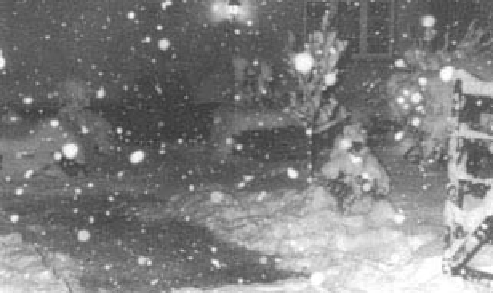Geoscience Reference
In-Depth Information
Rain
We have already discussed the main processes of rainfall
generation in
Chapter 4.
Here we are concerned with the
nature of the rainfall after it has fallen from the cloud.
Typically rainfall consists of water droplets that vary
in size. Where the rain is produced by thin, low-level
stratiform clouds, droplets tend to be small, with a
majority in the range from 0·2 mm to 0·5 mm in diameter.
Where the clouds are thicker, the droplets are able to
grow for longer, so the number of collisions increases and
the rain is composed of larger droplets, often several
millimetres in diameter. Stronger updraughts can also
increase the droplet size, as the droplet cannot fall by
gravity as quickly. The diameter of a droplet is also affected
by events during its fall through the atmosphere. In
general, the droplets reaching the ground show a
logarithmic size distribution, with a large number of small
droplets and a much smaller number of large drops.
The size of the droplets has considerable significance,
for, together with the strength of updraughts in the air, it
controls the fall velocity of the rain. In still air the fall
speed of a droplet 0·2 mm in diameter is about 70 cm s
-1
;
for a drop of 2 mm diameter, it is about 650 cm s
-1
.The
momentum of the droplet when it reaches the ground is
known as the terminal velocity, and, with the mass of the
drop, determines its kinetic energy.
The total kinetic energy of a storm depends upon the
number of raindrops reaching the ground. This is a
measure of the rainfall intensity. Rainfall intensity varies
considerably both within an individual storm and
between storms. Rainfall from thick cumulus-type clouds
is particularly variable, owing to spatial differences in
cloud thickness and updraught strength, but intensities
may be as high as 200 mm hr
-1
or more for short periods.
Precipitation from stratiform clouds is less variable and
intensities are usually low - less than 5 mm hr
-1
. This is
why tropical rainstorms can have more dramatic effects
on soil erosion than temperate rainfall.
Period
Duration Depth
Intensity
(hr)
(mm)
(mm hr
-1
)
Heaviest clock hour
1
5
5
Heaviest three-hour period
3
11
3·7
Heaviest six-hour period
6
17
2·8
Heaviest twelve-hour period
12
26
2·2
Heaviest twenty-four-hour
24
38
1·6
period
Total storm
42
49
1·2
Source: After Miller (1977).
throughout the year, the majority of precipitation falls as
snow. Even so, because of the low temperatures preventing
the atmosphere holding much moisture, many of these
areas are, in fact, quite arid. There are no adequate records
to provide accurate values, but it seems likely that on a
world basis no more than 1 per cent of the total annual
precipitation occurs as snow.
Snowfall usually starts in the atmosphere as tiny ice
crystals produced at temperatures well below freezing. As
the crystals fall they tend to aggregate, particularly where
there is sufficient moisture in the air to bind the crystals
together. This mainly occurs where temperatures are
close to freezing point, and in these conditions large snow-
moisture is lacking and the crystals do not aggregate.
As with rain, the fall velocity of the snowflakes depends
on size and, all else being equal, large flakes fall more
rapidly than small ones, with maximum speeds of about
100 cm s
-1
. As we all know, however, snowflakes vary
considerably in shape and that too may influence fall
speeds. Moreover the density of snowflakes is very low;
large flakes often have a density of as little as 100 kg m
-3
Snow
In most areas of the world, rainfall is by far the most
important input to the surface hydrological system. In
some areas significant inputs can fall in the form of snow.
Snow occurs mainly in winter, and, despite its thickness
and persistence, the quantities of moisture involved are
fallen snow produces only about 10 mm of water. Where
snow is formed in very cold, dry air the moisture
equivalent is even smaller, and it may take as much as a
metre of snow to produce 10 mm of water. In high
mountain and polar regions where temperatures are low
Photo: C. J. Richards












































